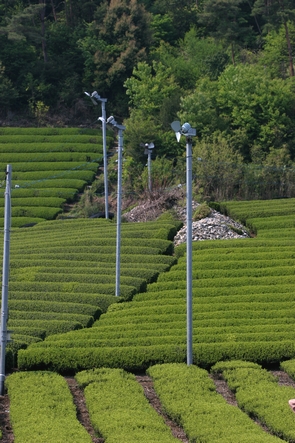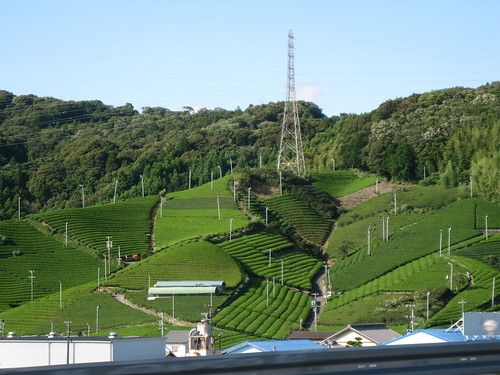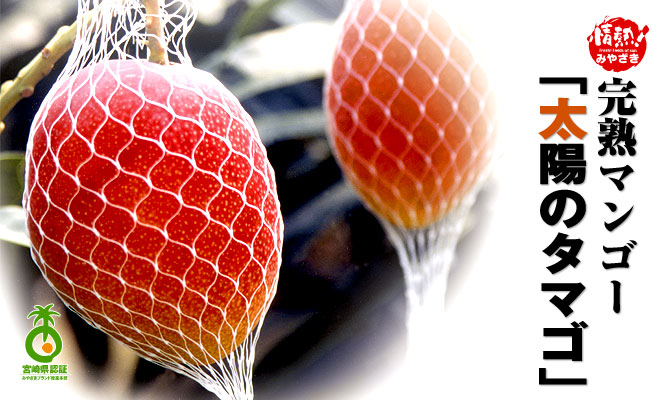Kinwashi Tour Japan Thread
-

-

-
-
Fans for tea fields
Posted in Country : Japan, Tea plant by François-Xavier Delmas | Tags : Country : Japan, Shizuoka, tea field, tea fields, Tea plant, tea plants, tea tree, tea trees
Some sights in the tea fields in Japan are strange. The green rows of tea trees are covered with fans stuck up on top of numerous posts and their metal spikes give contrast to the soft aspects of spring. What can they actually be for? Give a little breeze when the sun is too hot? Certainly not! The fans will fully play their part in the middle of winter. They will be switched on in order to give the atmosphere a stir and prevent the layers of cold air to stay above the trees. These layers of cold air could indeed damage the small trees or slow down their growth.
-
Travel as you learn.
by now your should know.
after showing the above, picture and video.
Why do they have electric fans in tea fields in japan?
-
-
sourceShizuoka is known for many things in Japan, most of all Mount Fuji, but followed closely by green tea! The mountainous and wet environment makes it a perfect place for growing delicious tea… and the tea fields look pretty good as you drive by on the highway or ride by on the train or shinkansen.
Tea from Kagoshima Prefecture and Mie Prefecture is also highly regarded.
The picture you see below is of tea fields on tea plantations near the highway in Shizuoka. Ito En, a company that produces over 20% of the tea in Japan is located a bit up the highway from these two fields so they may in some way be affiliated.
Now for the good stuff!
NOTE the fans that are spread out through the fields… can you guess what they are for?
The fans push warm air back down to the plants to prevent frost and try to keep the temperatures of all the tea bushes as consistent as possible. Apparently the tea’s flavor is affected if the bushes frost over or if the ground they are in gets too cold.

-
-
-
http://www.japanesetea.co.uk/health.htm
source
Green tea health
The advantages of drinking green tea:
- Green tea helps to prevent cancer. Mortality rates from cancer are low in Japan and especially low in Shizuoka where the consumption of green tea is highest. The main component of green tea is catechins which have a proven effect on the reduction of cancer rates.
- Green tea restricts the increase of blood cholesterol. Cholesterol causes a range of diseases in adults. The catechins in green tea restrict the build up of blood cholestrol.
- Green tea controls high blood pressure. Green tea is known to help control blood pressure, catechins impede the action of chemicals that are known to effect cause blood pressure.
- Green tea lowers the blood sugar level. Green tea has the capability of lowering blood sugar levels. The catechins and polysaccharides in green tea have been shown to play a key role in this reduction, this has helped in the treatment of diabetes.
- Green tea can help to suppress ageing. Powerful antioxidising agents such as vitamin E and vitamin C restrain the ageing process, green tea contains both these vitamins. The main active ingredient of green tea, catechin, is thought to be a far stronger antioxidant than the two vitamins, adding to the strong weight of evidence that suggests green tea makes you look younger.
- Green tea refreshes the body. Green tea contains caffeine which has a strong stimulating effect. Green tea has an advantage over coffee because the green tea caffeine combines with catechin to produce a rather milder, more natural, effect.
- Green tea deters food poisoning. Green tea has the ability to kill certain bacteria. For instance, it's strong sterilizing effect on bacteria is used in the treatment of diarrhea.
Green tea health benefits
Green tea is considered as one of the three major non-alcoholic beverages in the world. Although there are no definite records about when and how green tea was first brought to Japan, it is believed that Buddhist priests from China and India, and Japanese envoys dispatched to China brought green tea to Japan in the 8th century.
The first attempt of green tea cultivation in Shizuoka dates back to the late 19th century when 200 samurais of the Tokugawa shogunate, who were clan headed by Kageki Chujo, began to cultivate green tea on the Makinohara plateau; green tea cultivation has been well established in Shizuoka since then.
Today, green tea is mainly grown on plateaus, sloping fields, and basins by large rivers in Shizuoka prefecture except in Izu peninsula.

-

-


Home "egg of the sun" ripe mango Miyazaki brand items >> Introduction >> 


Miyazaki mango, harvest only the ones caught in the net bag with fruit drop naturally stick to the "ripe", ripen on the vine.
Unforgettable ate once, a thick sweet I'm fascinated by a lot of fans in the tropical.

~ How to harvest the delicious fruit - only
because in any fruit, it got a lot of good nutrition the mother tree, when I'm away from the tree is the most delicious.
Wrapped in the net every single fruit so as not to miss the moment, mango ripe, we harvest the fruit waiting for you to fruit drop naturally to the internet.
In this way, to give you a stable to everyone who consume enough fruit store the original mango taste, the smell, the production area, we are committed to a planned production and shipment.
※ mango is a plant of the family sumac. The constitution may be rash, etc. of mango juice. Served with a fork, etc., directly, person who worried, be careful not to touch the skin. 

â– Product Brand Certification Standards Were allowed to mature on the vine until the fruit drop naturally (1), fruit with excellent appearance, taste, especially
fruit meet unified standards prefecture Keizairen (2) determine
grade: greater than or equal to "秀blue"
over "2L": class-
- Brix: more than "15 degrees"
or more pesticide residue testing conducted in February during shipment specimen (3)
â– Product Brand origin certification criteria The organization committee (1) has been established
that the scale origin (2) is equal to or greater than 1ha in general
that you are doing the production and shipment deliberate (3)
Quality Management (4), inspection system, such as claims processing shipping system that has been established
that it is a record of the development production management (5)
â– Product brand name of the locality Daitaba Kushima Hamayu JA JA JA Miyazaki central
tail tin Koyu JA JA JA Hinata Kobayashi, Saito JA JA
-
Come to Kagoshima, and just happen this also mangoes season.
my friend Suzuki chan father given us eight of us each one of this, to be taken back as gift.
and another 2 pieces we cut and ate it there, total 10 pieces.
must be expensive one box with only one piece packed inside.

-

-
Currently out of stock,
but if you wanted to know the price get some ideal here.
-
one interesting thing mesurement on the sweetest, we can use this gadget.
source

-
-
-
-
http://english.ryukyushimpo.jp/2012/07/28/7594/
Okinawa Prefectural Government produces new Okinawan mangoes

The Prefectural Agriculture, Forestry and Fisheries Department registered trademarks of new Okinawan mangoes, called natsukobeni(left) and tilala.
July 13, 2012 Ryukyu Shimpo
On July 12, the Agriculture, Forestry and Fisheries Department (AFFD) of the Okinawa Prefectural Government (OPG) announced two new varieties of Okinawan mango called natsukobeni and tilala. They are the first mangoes to be brought from the United States and then developed in Japan. The OPG registered both trademarks in June and will increase production volume and work to strengthen the brand power of Okinawan mangoes. The production volumes for this term are expected to be 1680 kilograms (3704 pounds) for natsukobeni and 440 kilograms (970 pounds) for tilala.
The difference between the two varieties of mangoes is that natsukobeni has round fruit and is very sweet and tilala has an oval-shaped fruit and a sweet-sour taste. The harvest season is from late July to early September, which is between the end of harvest time for the Irwin variety and the beginning of the picking season for Keitt, other mangoes grown in Okinawa. The OPG expects that the new varieties will lengthen the harvest season and increase the total production volume of Okinawan mangoes.
The new varieties are lipense for natsukobeni and Valencia pride for tilala.
The AFFD has grown 18 varieties of mangoes from cuttings sent by the United States Department of Agriculture in 2003. They selected these two varieties because of their suitability to the environment in Okinawa, and have bred them on a trial basis at Nakijin and in Miyako-jima since 2007. Targeting more affluent people and repeat customers, this year it will start to sell the mangoes.
The production volume in five years time is expected to be 100 tons for natsukobeni, and 71 tons for tilala. Takeshi Chinen, the head of AFFD said, “We aim to produce these mangoes as an original Okinawan brand and hope that this will help to increase farmer’s income. We hope that areas producing mangoes will develop in the future.”
-
-
Products lineup of Senka mango Okinawa.

Apple Mango specified locality (town Yaese)
Shop with confidence recommend "mango production area specified" is a ripe mango painstakingly raised in the town in the southern part of the main island of Okinawa Yaese. By limiting the production area, we deliver consistent quality apple mango.
Including those who are limited in our production Mr. Nakachi, Mr. mango farmers in the town Yaese.


Apple's mango Nagamine
Mr. Nagamine was limited to producers, it is a delicious apple mango safe and secure on it.
Mr. Nagamine is to get the Eco Farmer in Tomato and mango cultivation. The Eco-Farmer is a title you are an agricultural work integrally with the three technologies "technology to reduce pesticide and chemical reduction techniques fertilizer and chemical technologies for manufacturing earth", it is given only to those who have received certification from the province. Mr. Yasuhiro Nagamine is this the Eco Farmer mango and tomato cultivation has acquired. Click here for more information, → About Eco Farmer


Apple's mango Nagamine (picking first)
Although mango take around five years to harvest from planting seedlings, it is the first to be harvested mango. I was named "Mango picking first" it.(Naming our)
nutrition is concentrated, "Mango picking first this", because it does not finish very tasty mango apple to put a real one in only one branch on which to put a real first. (Dan San farmers)
now, "Mango picking the first" good luck in the new fields are harvested Nagamine's.
Because it is a guidance of contract in limited quantities, please purchase as soon as possible.


(Mango Chura) mangue Chura
Title given to only the mango was clear, size, etc. Irodzuki sugar content, the harsh conditions.
"(Mango Chura) mangue Chura" ... it is
the other, may not be eaten ripe mango other ...

That helped me toward
Okinawa mango is
How do you like it? -
source
All the nutrition is absorbed until the last minute of natural fall, Miyako born fully-ripened fruit画��供:JA����Mangoes that grow in Okinawa, Miyazaki, and most part of Japan are Irwin apple mangoes. The fruit is oval shaped weighing around 400g to 500g, covered with red peel. The orange colored fruit has perfect balance of sour and sweetness and melts in your mouth. Shipping time is around June to August. Miyako Island mangos are very popular in Okinawa, the full ripe mango filled with nutrition is only picked after it has naturally fallen. The mango smells kind of like an apple, with sweet juice that drips when you cut it and is it also high in fiber. The giant and rare Keitt mangos are also grown in Okinawa. It's still green even when it is ripe with a very sweet taste.





